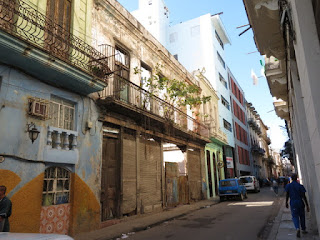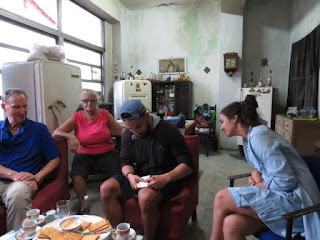First a quick explanation about Cuban currency. There are pesos convertibles (CUC) and
national pesos (CUP). One CUC is worth
25 CUP. Most Cubans are paid in CUP but
tourists mainly use CUC. Either currency
is accepted for the most part.
 |
| Convertible (CUC) pesos and national pesos (CUP) |
Our first excursion was with Jorge, a “Tour with an
Economist”. We met Jorge at a park near
our house along with two other older couples from Boston who were traveling
together and a couple from England that are on a 10 year round the world camper
trip (see https://thisbigroadtrip.com/)! They did not bring their camper to Cuba. Jorge and his friend (also named Jorge) are
both trained as economists, but never practiced. About 80% of Cubans are employed by the government,
but government salaries average 30CUC/month.
A beer costs 1 CUC, dinner for two at a nice restaurant, 30 CUC. Not that you can’t get a pizza and soda at a government
restaurant for about 1 CUC. But basically you can’t live off the average
government salary so everyone has “la busqueda”, the search, for other ways to
earn money. The Jorges are getting in 2 economic
excursions a day plus another all day excursion to the family farm outside of
Havana 2 days a week through AirBnB and even with fees paid to AirBnB,
transfers of money from a Miami-based company to a Cuban bank account, and
government taxes, they could probably make 30 CUC a day if they have several people
on each tour. On the other hand, they
have other people that help with the tour that they pay money to as well.
For our tour, the first step was taking a public bus. I have never been on a bus or subway where I
felt more like a sardine than on this bus. Even a sardine would have more space
I think. Fortunately the ride was only about 5 minutes. Bus rides cost about 0.40 CUP. When we got off the bus Jorge explained about
people who can find things. These are
the people who know how to get things not generally available at a store. For example, can’t find a mattress, ask a guy
hanging out in front of a store and he
can take you to another guy who has a bunch of mattresses. Where do these come from? Well,
maybe someone who works at the state mattress factory declares some
mattresses to be “defective”. Another
guy is paid off to not notice that the mattresses didn’t get destroyed but were instead loaded into a truck. Then you might also need to pay someone to
gather receipts that weren’t collected by a buyer and one of those receipts
becomes yours to show you “legally” bought the item. People sell all kinds of things out of little
storefronts or just sitting along a shopping street. Like in Russia, if you see a line in front of
a store, get in it, because someone must be selling something you need. Jake spent more time than I did exploring
exactly what people were selling and for how much. We stopped for juice at a stand where juice
costs 2 CUP, rather than the 2 CUC we had paid earlier in the day at a
restaurant in the tourist area.
The tour ended at Granma’s house. She was probably in her 70s and had lived in
Old Havana. After the Revolution their
apartment building was condemned and torn down and they were sent to live in a
shelter, for 20 years. The shelter was like a big warehouse with partitions for
your living space. Shared bathrooms and
kitchen. She said she knocked on a lot
of doors trying to get compensation and a new place to live. Eventually she was given the opportunity to
buy an apartment at a subsidized rate with money deducted from her husband’s
paycheck. She and her husband are
divorced now, but they continue to live in the apartment together. I asked why she had three refrigerators and
she said 2 were hers and one was her husband’s.
She gets a pension of about 10 CUC a month and supplements this by
baking croquetas for parties, mending and altering clothing, and of course
hosting the people on these tours. She
provided rum and cokes (Cuba libres, the coke being the national brand, not
CocaCola) and crackers with a mayonnaise spread.
Many goods are “seasonal”.
Sometimes literally only available during certain seasons, but more
often just meaning a temporary shortage.
When we were there, there was a shortage of flour for instance. Brazil has elected a new right wing president
and most flour importation comes from Brazil.
The Cuban government disapproves of the new Brazilian government and now
Cuba gets no flour from Brazil. Yanelis
had a big water purifier in her home, but she can’t find filters for it right
now even though the thing was produced in Cuba.
Our other tour was a “farm to table” tour. I’ll talk more about the farm in a post on
food, but our guide for that tour was trained as a lawyer but has spent most of
his career working for tour companies. Our
driver was a mechanical engineer and he does some consulting work for an
Italian company, works some with a government agency, and does the marketing
for the farm to table tour. One of our
cab drivers is a physical therapist but just bought a 1958 car that he is going
to fix up to drive people around. Maria’s
husband worked as a gardener at the national botanical garden for a number of
years but the salary was too low and now he has a license to operate a cart
from which he sells crackers and apparently he makes more money doing that than
as a gardener.
The fact that you can’t make a decent living as a professional
despite a free education system has meant that many people are forgoing college
now to work in the private service industry instead. Cuba has been exporting doctors and doctors
who agree to work abroad basically get a bonus paid for by the other
country. Brazil had several thousand
Cuban doctors, but the new government wanted to pay the doctors directly rather
than pay the Cuban government, and so Cuba has withdrawn all those doctors.
 |
| A typical street in Central Havana |
 |
| Parks are wifi hot spots and so everyone goes there to check their messages. You purchase wifi access on a card purchased from the government via street kiosks mostly. |
 |
| Revitalization continues from Old Havana into Centro along a pedestrian only street |
 |
| A receipt showing the price in CUC vs CUP |
 |
| Along the Malecon looking towards Central Havana |
 |
| School kids on their lunch break |
If you do earn more than $2000 CUC a year in a private
business you have to declare that income and it is taxed at 50%. Hmm, wonder how many people declare that cash
income they are receiving? There are
though still “spies” in every neighborhood who might report an increase in spending
on goods or major home repair or speaking out against government policies. Many of these people have themselves been
caught doing something illegal and reporting on others keeps them out of jail.

No comments:
Post a Comment